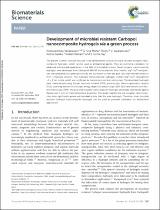 ResearchSpace
ResearchSpace
Development of microbial resistant Carbopol nanocomposite hydrogels via a green process
JavaScript is disabled for your browser. Some features of this site may not work without it.
- ResearchSpace
- →
- Research Publications/Outputs
- →
- Journal Articles
- →
- View Item
| dc.contributor.author |
Varaprasad, K

|
|
| dc.contributor.author |
Reddy, SM

|
|
| dc.contributor.author |
Jayaramudu, J

|
|
| dc.contributor.author |
Sadiku, R

|
|
| dc.contributor.author |
Ramama, K

|
|
| dc.contributor.author |
Ray, Suprakas S

|
|
| dc.date.accessioned | 2014-09-11T06:45:43Z | |
| dc.date.available | 2014-09-11T06:45:43Z | |
| dc.date.issued | 2014 | |
| dc.identifier.citation | Varaprasad, K, Reddy, S.M, Jayaramudu, J, Sadiku, R, Ramama, K and Ray, S.S. 2014. Development of microbial resistant Carbopol nanocomposite hydrogels via a green process. Biomaterials Science, vol. 2, pp 257- 263 | en_US |
| dc.identifier.issn | 2047-4830 | |
| dc.identifier.uri | http://pubs.rsc.org/en/content/articlepdf/2014/bm/c3bm60185d | |
| dc.identifier.uri | http://hdl.handle.net/10204/7661 | |
| dc.description | Copyright: 2014 Royal Society of Chemistry. Published in Biomaterials Science, vol. 2, pp 257- 263 | en_US |
| dc.description.abstract | The present scientific research resulted in the development of novel microbial resistant inorganic nanocomposite hydrogels, which can be used as antibacterial agents. They are promising candidates for advanced antimicrobial applications in the field of biomedical science. Novel inorganic nanocomposite hydrogels were developed from Carbopol® 980 NF and acrylamide. Dual-metallic (Ag(sup0)–Au(sup0)) nanoparticles were prepared (via a green process) by the nucleation of silver and gold salts with mint leaf extract to form a hydrogel network. The Carbopol nanocomposite hydrogels contain (Ag(sup0)–Au(sup0)) nanoparticles [similar]5 ± 3 nm in size, which was confirmed by transmission electron microscopy. The developed hydrogels were characterized using Fourier transform infrared (FTIR) spectroscopy, thermo-gravimetric analysis (TGA), scanning electron microscopy-energy dispersive spectroscopy (SEM-EDS) and transmission electron microscopy (TEM). The pure and inorganic nanocomposite hydrogels developed were tested against Bacillus and E. coli, for their antibacterial properties. The results indicate that the inorganic nanocomposites show significantly greater antimicrobial activity than the pure hydrogels. Therefore, novel microbial resistant Carbopol nanocomposite hydrogels can be used as potential candidates for antibacterial applications. | en_US |
| dc.language.iso | en | en_US |
| dc.publisher | Royal Society of Chemistry | en_US |
| dc.relation.ispartofseries | Workflow;13396 | |
| dc.subject | Microbial resistant | en_US |
| dc.subject | Carbopol | en_US |
| dc.subject | Nanocomposites | en_US |
| dc.subject | Hydrogel | en_US |
| dc.subject | Green processes | en_US |
| dc.title | Development of microbial resistant Carbopol nanocomposite hydrogels via a green process | en_US |
| dc.type | Article | en_US |
| dc.identifier.apacitation | Varaprasad, K., Reddy, S., Jayaramudu, J., Sadiku, R., Ramama, K., & Ray, S. S. (2014). Development of microbial resistant Carbopol nanocomposite hydrogels via a green process. http://hdl.handle.net/10204/7661 | en_ZA |
| dc.identifier.chicagocitation | Varaprasad, K, SM Reddy, J Jayaramudu, R Sadiku, K Ramama, and Suprakas S Ray "Development of microbial resistant Carbopol nanocomposite hydrogels via a green process." (2014) http://hdl.handle.net/10204/7661 | en_ZA |
| dc.identifier.vancouvercitation | Varaprasad K, Reddy S, Jayaramudu J, Sadiku R, Ramama K, Ray SS. Development of microbial resistant Carbopol nanocomposite hydrogels via a green process. 2014; http://hdl.handle.net/10204/7661. | en_ZA |
| dc.identifier.ris | TY - Article AU - Varaprasad, K AU - Reddy, SM AU - Jayaramudu, J AU - Sadiku, R AU - Ramama, K AU - Ray, Suprakas S AB - The present scientific research resulted in the development of novel microbial resistant inorganic nanocomposite hydrogels, which can be used as antibacterial agents. They are promising candidates for advanced antimicrobial applications in the field of biomedical science. Novel inorganic nanocomposite hydrogels were developed from Carbopol® 980 NF and acrylamide. Dual-metallic (Ag(sup0)–Au(sup0)) nanoparticles were prepared (via a green process) by the nucleation of silver and gold salts with mint leaf extract to form a hydrogel network. The Carbopol nanocomposite hydrogels contain (Ag(sup0)–Au(sup0)) nanoparticles [similar]5 ± 3 nm in size, which was confirmed by transmission electron microscopy. The developed hydrogels were characterized using Fourier transform infrared (FTIR) spectroscopy, thermo-gravimetric analysis (TGA), scanning electron microscopy-energy dispersive spectroscopy (SEM-EDS) and transmission electron microscopy (TEM). The pure and inorganic nanocomposite hydrogels developed were tested against Bacillus and E. coli, for their antibacterial properties. The results indicate that the inorganic nanocomposites show significantly greater antimicrobial activity than the pure hydrogels. Therefore, novel microbial resistant Carbopol nanocomposite hydrogels can be used as potential candidates for antibacterial applications. DA - 2014 DB - ResearchSpace DP - CSIR KW - Microbial resistant KW - Carbopol KW - Nanocomposites KW - Hydrogel KW - Green processes LK - https://researchspace.csir.co.za PY - 2014 SM - 2047-4830 T1 - Development of microbial resistant Carbopol nanocomposite hydrogels via a green process TI - Development of microbial resistant Carbopol nanocomposite hydrogels via a green process UR - http://hdl.handle.net/10204/7661 ER - | en_ZA |





